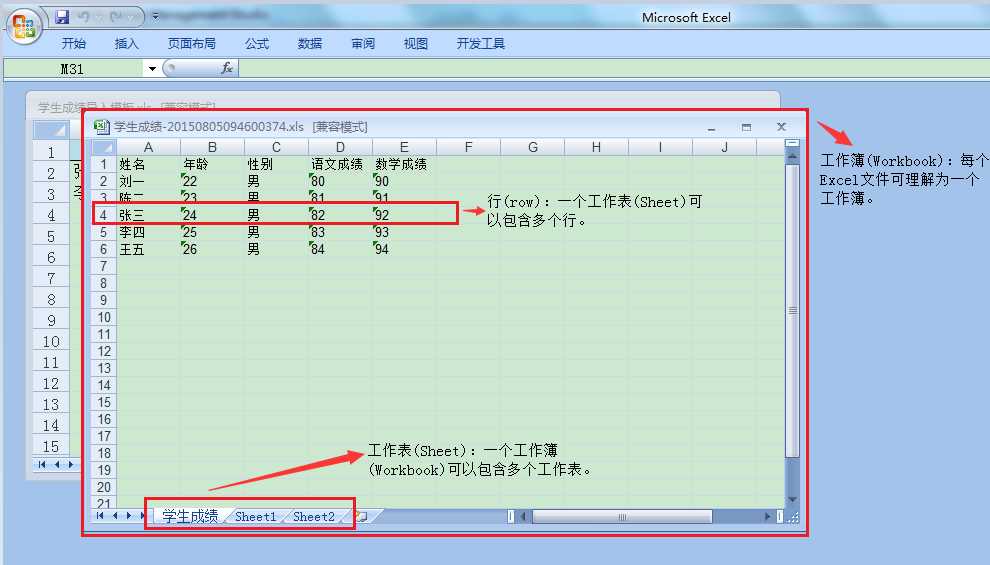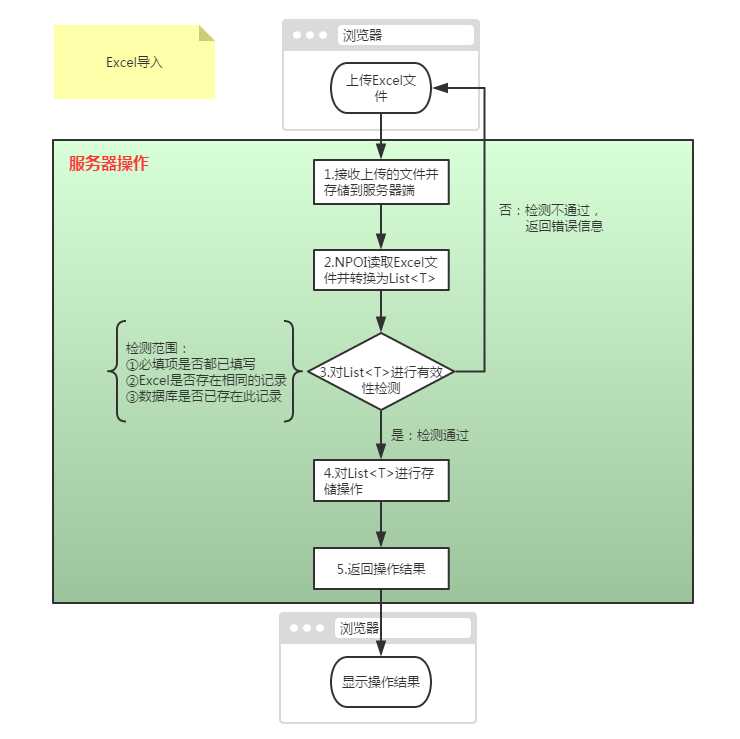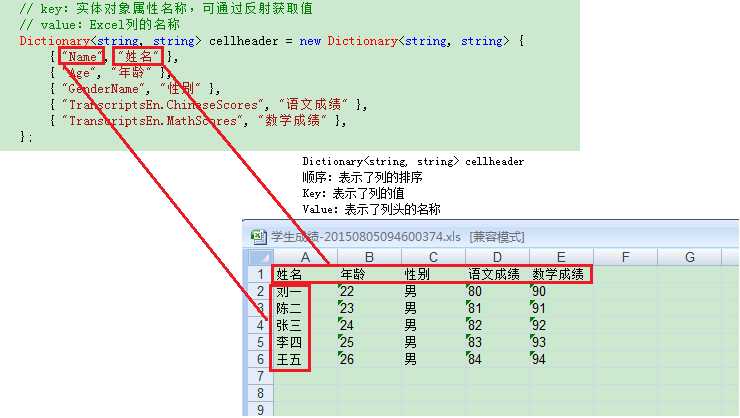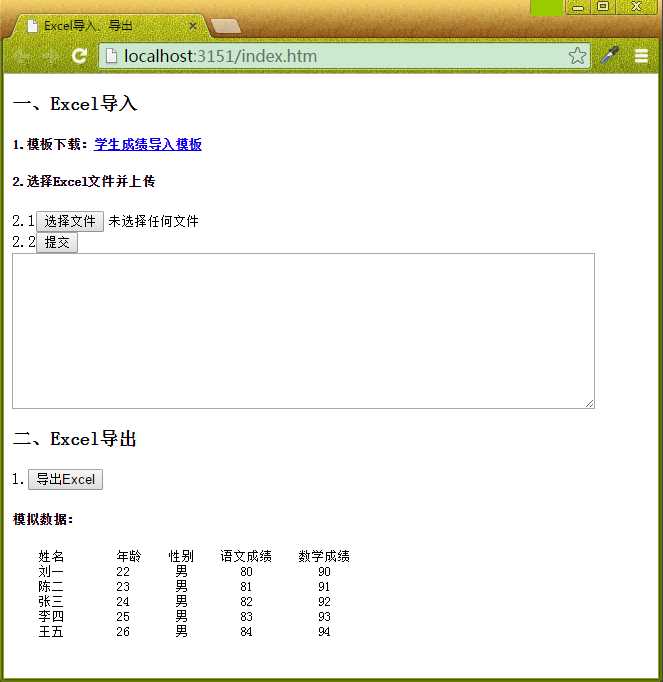标签:
1. 介绍:描述第三方类库NPOI以及Excel结构
2. Excel导入:介绍C#如何调用NPOI进行Excel导入,包含:流程图、NOPI以及C#代码
3. Excel导出:介绍C#如何调用NPOI进行Excel导出,包含:流程图、NOPI以、C#代码以及代码分析
4. 源码下载:展示运行图及源码下载
说明:NPOI是POI项目的.NET 版本,可用于Excel、Word的读写操作。
优点:不用装Office环境。
下载地址:http://npoi.codeplex.com/releases
工作簿(Workbook):每个Excel文件可理解为一个工作簿。
工作表(Sheet):一个工作簿(Workbook)可以包含多个工作表。
行(row):一个工作表(Sheet)可以包含多个行。


说明:把Excel文件转换为List<T>
步骤:
①读取Excel文件并以此初始化一个工作簿(Workbook);
②从工作簿上获取一个工作表(Sheet);默认为工作薄的第一个工作表;
③遍历工作表所有的行(row);默认从第二行开始遍历,第一行(序号0)为单元格头部;
④遍历行的每一个单元格(cell),根据一定的规律赋值给对象的属性。
代码:
说明:对Excel转换后的List<T>进行后续操作;如:检测有效性、持久化存储等等
步骤:
①调用2.2代码,把Excel文件转换为List<T>。
②对List<T>进行有效性检测:必填项是否为空、是否有重复记录等等。
③对List<T>进行持久化存储操作。如:存储到数据库。
④返回操作结果。
代码:
|
1
2
3
4
5
6
7
8
9
10
11
12
13
14
15
16
17
18
19
20
21
22
23
24
25
26
27
28
29
30
31
32
33
34
35
36
37
38
39
40
41
42
43
44
45
46
47
48
49
50
51
52
53
54
55
56
57
58
59
60
61
62
63
64
65
66
67
68
69
70
71
72
73
74
75
76
77
78
79
80
81
82
83
84
85
86
87
88
89
90
91
92
93
94
95
96
97
98
|
public void ImportExcel(HttpContext context){ StringBuilder errorMsg = new StringBuilder(); // 错误信息 try { #region 1.获取Excel文件并转换为一个List集合 // 1.1存放Excel文件到本地服务器 HttpPostedFile filePost = context.Request.Files["filed"]; // 获取上传的文件 string filePath = ExcelHelper.SaveExcelFile(filePost); // 保存文件并获取文件路径 // 单元格抬头 // key:实体对象属性名称,可通过反射获取值 // value:属性对应的中文注解 Dictionary<string, string> cellheader = new Dictionary<string, string> { { "Name", "姓名" }, { "Age", "年龄" }, { "GenderName", "性别" }, { "TranscriptsEn.ChineseScores", "语文成绩" }, { "TranscriptsEn.MathScores", "数学成绩" }, }; // 1.2解析文件,存放到一个List集合里 List<UserEntity> enlist = ExcelHelper.ExcelToEntityList<UserEntity>(cellheader, filePath, out errorMsg); #endregion #region 2.对List集合进行有效性校验 #region 2.1检测必填项是否必填 for (int i = 0; i < enlist.Count; i++) { UserEntity en = enlist[i]; string errorMsgStr = "第" + (i + 1) + "行数据检测异常:"; bool isHaveNoInputValue = false; // 是否含有未输入项 if (string.IsNullOrEmpty(en.Name)) { errorMsgStr += "姓名列不能为空;"; isHaveNoInputValue = true; } if (isHaveNoInputValue) // 若必填项有值未填 { en.IsExcelVaildateOK = false; errorMsg.AppendLine(errorMsgStr); } } #endregion #region 2.2检测Excel中是否有重复对象 for (int i = 0; i < enlist.Count; i++) { UserEntity enA = enlist[i]; if (enA.IsExcelVaildateOK == false) // 上面验证不通过,不进行此步验证 { continue; } for (int j = i + 1; j < enlist.Count; j++) { UserEntity enB = enlist[j]; // 判断必填列是否全部重复 if (enA.Name == enB.Name) { enA.IsExcelVaildateOK = false; enB.IsExcelVaildateOK = false; errorMsg.AppendLine("第" + (i + 1) + "行与第" + (j + 1) + "行的必填列重复了"); } } } #endregion // TODO:其他检测 #endregion // 3.TODO:对List集合持久化存储操作。如:存储到数据库 // 4.返回操作结果 bool isSuccess = false; if (errorMsg.Length == 0) { isSuccess = true; // 若错误信息成都为空,表示无错误信息 } var rs = new { success = isSuccess, msg = errorMsg.ToString(), data = enlist }; System.Web.Script.Serialization.JavaScriptSerializer js = new System.Web.Script.Serialization.JavaScriptSerializer(); context.Response.ContentType = "text/plain"; context.Response.Write(js.Serialize(rs)); // 返回Json格式的内容 } catch (Exception ex) { throw ex; }} |

说明:把List<T>转换为Excel
步骤:
①创建一个工作簿(Workbook);
②在工作簿上创建一个工作表(Sheet);
③在工作表上创建第一行(row),第一行为列头,依次写入cellHeard的值(做为列名)。
④循环遍历List<T>集合,每循环一遍创建一个行(row),然后根据cellHeard的键(属性名称)依次从List<T>中的实体对象取值存放到单元格内。
代码:
|
1
2
3
4
5
6
7
8
9
10
11
12
13
14
15
16
17
18
19
20
21
22
23
24
25
26
27
28
29
30
31
32
33
34
35
36
37
38
39
40
41
42
43
44
45
46
47
48
49
50
51
52
53
54
55
56
57
58
59
60
61
62
63
64
65
66
67
68
69
70
71
72
73
74
75
76
77
78
79
80
81
82
83
84
85
86
87
88
89
90
91
92
93
94
95
96
97
98
99
100
101
102
103
|
/// <summary>/// 实体类集合导出到Excle2003/// </summary>/// <param name="cellHeard">单元头的Key和Value:{ { "UserName", "姓名" }, { "Age", "年龄" } };</param>/// <param name="enList">数据源</param>/// <param name="sheetName">工作表名称</param>/// <returns>文件的下载地址</returns>public static string EntityListToExcel2003(Dictionary<string, string> cellHeard, IList enList, string sheetName){ try { string fileName = sheetName + "-" + DateTime.Now.ToString("yyyyMMddHHmmssfff") + ".xls"; // 文件名称 string urlPath = "UpFiles/ExcelFiles/" + fileName; // 文件下载的URL地址,供给前台下载 string filePath = HttpContext.Current.Server.MapPath("\\" + urlPath); // 文件路径 // 1.检测是否存在文件夹,若不存在就建立个文件夹 string directoryName = Path.GetDirectoryName(filePath); if (!Directory.Exists(directoryName)) { Directory.CreateDirectory(directoryName); } // 2.解析单元格头部,设置单元头的中文名称 HSSFWorkbook workbook = new HSSFWorkbook(); // 工作簿 ISheet sheet = workbook.CreateSheet(sheetName); // 工作表 IRow row = sheet.CreateRow(0); List<string> keys = cellHeard.Keys.ToList(); for (int i = 0; i < keys.Count; i++) { row.CreateCell(i).SetCellValue(cellHeard[keys[i]]); // 列名为Key的值 } // 3.List对象的值赋值到Excel的单元格里 int rowIndex = 1; // 从第二行开始赋值(第一行已设置为单元头) foreach (var en in enList) { IRow rowTmp = sheet.CreateRow(rowIndex); for (int i = 0; i < keys.Count; i++) // 根据指定的属性名称,获取对象指定属性的值 { string cellValue = ""; // 单元格的值 object properotyValue = null; // 属性的值 System.Reflection.PropertyInfo properotyInfo = null; // 属性的信息 // 3.1 若属性头的名称包含‘.‘,就表示是子类里的属性,那么就要遍历子类,eg:UserEn.UserName if (keys[i].IndexOf(".") >= 0) { // 3.1.1 解析子类属性(这里只解析1层子类,多层子类未处理) string[] properotyArray = keys[i].Split(new string[] { "." }, StringSplitOptions.RemoveEmptyEntries); string subClassName = properotyArray[0]; // ‘.‘前面的为子类的名称 string subClassProperotyName = properotyArray[1]; // ‘.‘后面的为子类的属性名称 System.Reflection.PropertyInfo subClassInfo = en.GetType().GetProperty(subClassName); // 获取子类的类型 if (subClassInfo != null) { // 3.1.2 获取子类的实例 var subClassEn = en.GetType().GetProperty(subClassName).GetValue(en, null); // 3.1.3 根据属性名称获取子类里的属性类型 properotyInfo = subClassInfo.PropertyType.GetProperty(subClassProperotyName); if (properotyInfo != null) { properotyValue = properotyInfo.GetValue(subClassEn, null); // 获取子类属性的值 } } } else { // 3.2 若不是子类的属性,直接根据属性名称获取对象对应的属性 properotyInfo = en.GetType().GetProperty(keys[i]); if (properotyInfo != null) { properotyValue = properotyInfo.GetValue(en, null); } } // 3.3 属性值经过转换赋值给单元格值 if (properotyValue != null) { cellValue = properotyValue.ToString(); // 3.3.1 对时间初始值赋值为空 if (cellValue.Trim() == "0001/1/1 0:00:00" || cellValue.Trim() == "0001/1/1 23:59:59") { cellValue = ""; } } // 3.4 填充到Excel的单元格里 rowTmp.CreateCell(i).SetCellValue(cellValue); } rowIndex++; } // 4.生成文件 FileStream file = new FileStream(filePath, FileMode.Create); workbook.Write(file); file.Close(); // 5.返回下载路径 return urlPath; } catch (Exception ex) { throw ex; }} |
说明:对Excel转换后的List<T>进行后续操作;如:检测有效性、持久化存储等等
步骤:
①获取List<T>集合。
②调用3.2,将List<T>转换为Excel文件。
③服务器存储Excel文件并返回下载链接。
代码:
|
1
2
3
4
5
6
7
8
9
10
11
12
13
14
15
16
17
18
19
20
21
22
23
24
25
26
27
28
29
30
31
32
33
34
35
|
public void ExportExcel(HttpContext context){ try { // 1.获取数据集合 List<UserEntity> enlist = new List<UserEntity>() { new UserEntity{Name="刘一",Age=22,Gender="Male",TranscriptsEn=new TranscriptsEntity{ChineseScores=80,MathScores=90}}, new UserEntity{Name="陈二",Age=23,Gender="Male",TranscriptsEn=new TranscriptsEntity{ChineseScores=81,MathScores=91} }, new UserEntity{Name="张三",Age=24,Gender="Male",TranscriptsEn=new TranscriptsEntity{ChineseScores=82,MathScores=92} }, new UserEntity{Name="李四",Age=25,Gender="Male",TranscriptsEn=new TranscriptsEntity{ChineseScores=83,MathScores=93} }, new UserEntity{Name="王五",Age=26,Gender="Male",TranscriptsEn=new TranscriptsEntity{ChineseScores=84,MathScores=94} }, }; // 2.设置单元格抬头 // key:实体对象属性名称,可通过反射获取值 // value:Excel列的名称 Dictionary<string, string> cellheader = new Dictionary<string, string> { { "Name", "姓名" }, { "Age", "年龄" }, { "GenderName", "性别" }, { "TranscriptsEn.ChineseScores", "语文成绩" }, { "TranscriptsEn.MathScores", "数学成绩" }, }; // 3.进行Excel转换操作,并返回转换的文件下载链接 string urlPath = ExcelHelper.EntityListToExcel2003(cellheader, enlist, "学生成绩"); System.Web.Script.Serialization.JavaScriptSerializer js = new System.Web.Script.Serialization.JavaScriptSerializer(); context.Response.ContentType = "text/plain"; context.Response.Write(js.Serialize(urlPath)); // 返回Json格式的内容 } catch (Exception ex) { throw ex; }} |
核心代码主要是cellheader与List<T>之间的映射关系:


百度网盘: http://pan.baidu.com/s/1o69We8M
CSDN:http://download.csdn.net/download/polk6/8974195
==================================系列文章=========
c#使用NPOI进行Excel导入导出,附源码,vs2010
标签:
原文地址:http://www.cnblogs.com/shanwater/p/5636609.html